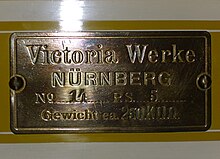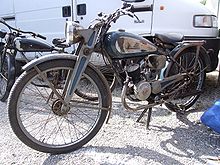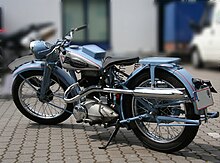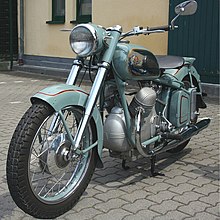Victoria works
| Victoria-Werke AG | |
|---|---|
| legal form | Corporation |
| founding | 1886 (as Frankenburger and Ottenstein Nürnberg ) |
| resolution | 1958 |
| Reason for dissolution | Merger with the express works and DKW two-wheeler production of Auto-Union GmbH to form Zweirad Union AG |
| Seat | Nuremberg , Germany |
| management |
|
| Number of employees |
|
| Branch | Hochrad manufacturers , bicycle manufacturers , motorcycle manufacturers , automotive manufacturers |
| Website | www.victoria-fahrrad.de |
The two-wheeler brand Victoria was first founded in 1886 as "Frankenburger und Ottenstein Nürnberg", was part of the Zweirad Union in 1958 and ended in 1968 with the takeover by Hercules . She was one of the pioneers in the Nuremberg motorcycle industry .
Company foundation and first products
In 1886 Max Frankenburger and Max Ottenstein founded the company "Frankenburger und Ottenstein Nürnberg" in the Nuremberg suburb of Gleißhammer . First high bikes and so-called safety bikes were produced. In 1888, the 1,000th Victoria bicycle left the factory, and in 1893 the factory had 259 employees. In 1895 the company was renamed "Victoria Fahrradwerke AG, formerly Frankenburger und Ottenstein". The share capital was 1.5 million marks. When the construction of motorcycles was to begin in 1899 , the name of the plant was changed to "Victoria Werke AG".
In 1896 there were the first bicycles with pneumatic tires , which were purchased from Dunlop. In 1900, the development of the first "Victoria motor vehicle" was completed, which was awarded the "Golden Medal" at the motor vehicle exhibition in Nuremberg at the time. Series production has not yet started, but individual copies were made for sale on request. In 1901, Victoria manufactured the first motorcycles. These had 1.75 hp, a surface carburetor and a flat belt for power transmission. The oil had to be pumped regularly with a hand pump. The fork was unsprung and the bottom bracket of the bicycle frame was retained. Gensets from Fafnir , FN , Cudell , Minerva and Zedel were used as built-in motors.
In 1904/1905, three-wheelers based on the motorcycle were built with a two-lane "sidecar" attached to the front . In addition, automobiles were now officially produced. The famous "Doctors Cabriolet", the "small motorized luggage wagon"; the "two-seater" and the "six-seater sedan" had little success and were only produced until 1912. In 1906 the first two-cylinder motorcycles with 2.5 to 3 hp were available. Like the first models, they were set in motion with pedals or a crank.
The Victoria models from 1920 to 1939


After the First World War, production began in 1920 with the most modern motorcycle of its time, the "KR I". It had an SV two-cylinder boxer engine ("M II B 15") from BMW, 494 cm³, two gears, 6.5 hp and the first telescope-like front fork. The boxer engine was installed transversely , that is, the crankshaft was perpendicular to the direction of travel, the cylinders were longitudinal. There was a rear brake with a wooden block as a brake pad.
After BMW manufactured its own motorcycles ( model R 32 ), the supply of the engines was discontinued. Martin Stolle has now joined Victoria as a new employee. Stolle, who previously worked for BMW, developed a new two-cylinder boxer engine with 9 hp with an OHV control system in 1922/23 , which was also installed transversely in the "KR II". This unit was initially manufactured by Wilhelm Sedlbauer in Munich. This plant was later bought by Victoria due to a lack of production capacity and production was relocated to Nuremberg. The "KR III" followed in 1924 with three gears and 12 hp.
In 1925 Steinlein built the first German supercharged engine near Victoria. In 1926 a 497 cm³ supercharged Victoria achieved a new world high of 165 km / h. In 1927 machines with 596 cm³ - "KR VI" - were built, in 1928 these models were renamed "KR 6" and high-performance sports machines with 24 HP and double carburettors (later as "KR 7") were also offered. At the same time, the 200 cm³ SV ("KR 20") and 350 cm³ OHV models ("KR 35") were released to round off the range at the bottom. In 1930/31, 500 cm³ SV ("KR 50") and OHV built-in motors ("KR 50 S") from Sturmey-Archer were added to the range.
In 1932 the models "KR 15" and "KR 20 Z" with two-stroke engines appeared, not their own designs, but built-in engines from ILO in Pinneberg. In the same year Victoria won the European Hill Climbing Championship for teams up to 600 cm³ with the "KR 6" and then named the model with a 20 hp engine and four-speed gearbox "KR 6 Bergmeister".
From 1933 the "KR 8" was built with a 497 cm³ SV parallel twin developed by Martin Stolle . A special feature of the engine design was the cylinder block that was almost horizontally in front of the crankcase . This drive replaced the Sturmey-Archer engine in other models in 1934 , which was no longer available due to an import ban.
In 1935 the "KR 9 Fahrmeister" received a further developed version of this engine with the rare EOI valve control ("Exhaust Over Inlet") . The "KR 35 B" and "KR 35 G" with Lackler patent cylinder heads, which were replaced in 1937 by the "KR 35 Sport" with Columbus OHV engine, are from the same year. New two-stroke engines from Richard and Xaver Küchen with flat-piston steep-flow flushing were intended for the "KR 20 LN Lux" and "KR 25 S Aero" models. From 1938 the four-stroke models "KR 35 SN" (18 HP) and "KR 35 SS" (20 HP) with Columbus engines were in the range. At the same time there were the two-stroke models "V 99 N Fix", "KR 12 N" and "KR 15 N" developed by Albert Roder .
With the outbreak of World War II in 1939, almost all two-wheeler production ended; only the “KR 35 Pionier” continued to be produced. The "Riedel-starter," one of Norbert Riedel constructed two-cylinder two-stroke - Boxer engine with extremely short stroke, which as a starter for the jet engines Junkers Jumo 004 and BMW 003 was used, was produced during the war in Victoria. The air raids on Nuremberg largely destroyed the plant, so that in 1945 only a small part of the production facilities was left.
New beginning after the Second World War
Post-war production began - after the temporary production of consumer goods such as kitchen machines, milk cans and tobacco cutters - at the end of 1946 with an auxiliary bicycle motor, the "FM 38" with flat piston and inlet rotary valve, which had a nominal output of about 1 hp with a displacement of 38 cm³; the FM 38 was the basis of the Victoria record machine . Albert Roder had designed this engine during the war, and shortly afterwards Roder switched to NSU . In 1949 the pre-war model "KR 25 Aero" was added to the range again and in 1950 the "V 99" was also back on the market as the "V 99 BL Fix". The "KR 25 Aero" was now delivered with a telescopic fork. In the meantime the models "Vicky I" and "Vicky II" were built with the FM-38 engines. At the turn of the year, the Victoria works had a workforce of 1,300 and had doubled sales compared to the pre-war level: over 40,000 built-in engines, approx. 14,000 KR 25 Aero, many 100 cm³ motorcycles, bicycles and freewheel hubs with a considerable export share.
In 1951 Georg Dotter Weich set a new world record of 79 km / h with an “FM 38” engine on the Munich – Ingolstadt motorway. The “KR 25 Aero” could now also be ordered with “Jurisch straight-way rear wheel suspension”, and the “KR 25 HM Aero” model with the high-performance engine, which was further developed from it, was added. In addition, the production of sophisticated sewing machines began.
In 1953 the company expanded its product range to include the “KR 26 Aero” (also further developed from the “KR 25”) and the “ V 35 Bergmeister ”, which was completely redeveloped by the brothers Xaver and Richard Küchen . It had a V-two-cylinder OHV engine, 350 cm³, 21 hp, a chain transmission and cardan drive. In 1954, Rudi Ebert won the 500 cc class with a "V 35 Bergmeister" in the 2500 km long distance Liège – Milan – Liège.
In 1955 the 200 cc two-stroke "Peggy" scooter designed by Norbert Riedel came onto the market. This was equipped with a new type of electromagnetic push-button circuit, electric starter, fan cooling and a drive train rear wheel swing arm. The technically similar motorcycle model "KR 21 Swing" was just as expensive to manufacture due to these high-quality technologies.
In 1957, the last Victoria motorcycle was built with the Italian 175 cm³ OHV engine from Parilla under the designation "KR 17 Parilla". The full swing chassis of this model was designed by Ernst Wüstenhagen. In the short construction period from 1957 to 1958, only just under 400 units were built, optionally with an engine output of 10.4 or 14.2 hp.
sparrow
As early as 1956, Bayerische Autowerke GmbH in Traunreut , founded by Victoria Zweirad Werke and Maschinenfabrik Friedrich , launched the “ Spatz 200 ”, a roadster with a plastic body, on the market to counteract the crisis in the two-wheeler industry. The Victoria dealer network took over the distribution. Initially, the Sparrow had a 4-speed 191 cc F&S engine, then a fan-cooled 250 cc VICTORIA two-stroke engine with a Peggy and Swing-like electromagnetic five-speed gearshift. This stronger version was called " Victoria 250 " and was built in Nuremberg. Despite its attractive shape, the small car found few buyers, so production was discontinued in February 1958. 1588 "Spatz 200" and "Victoria 250" were produced.
The end of the Victoria works
In 1958, sales fell dramatically across Germany, something that could not be offset by the moped models at Victoria either. Therefore, Victoria, the Express-Werke (Neumarkt) and the DKW two-wheel production of Auto-Union GmbH (Ingolstadt) merged to become Zweirad Union AG. Victoria brought its "Vicky" moped line, Express its "Radexi" and DKW its good name, as well as DKW Hummel, to the new company. Since from then on no “motorcycle people” belonged to the company management, but simply produced what could be sold better, Victoria was no longer a classic motorcycle manufacturer.
In 1966 the Zweirad Union was formally taken over by the Nuremberg Hercules Werke GmbH , with which the name "Victoria" finally disappeared from the price lists of motorcycle dealers.
Victoria brand revitalized
Hercules owned the rights to the name "Victoria", but had to cede them because they had not been used for more than five years. Then in 1995 Hermann Hartje KG in Hoya an der Weser secured the trademark rights and manufactured bicycles and electric bicycles with wheel hub motors from Panterra, Tranz-X, Panasonic and Bosch. Some of the models are manufactured at the headquarters in Hoya as well as by other bicycle manufacturers.
Technical data of the KR models
| Technical data Victoria KR I to KR VII | |||||||
|---|---|---|---|---|---|---|---|
| model | KR I | KR II | KR III | KR VI | KR VII | ||
| Type | Two-cylinder boxer ( SV ) | Two-cylinder boxer ( OHV ) | |||||
| Bore × stroke (mm) | 68 × 68 | 70.5 × 64 | 77 × 64 | ||||
| Displacement (cm³) | 494 | 499.4 | 596 | ||||
| PS at 1 / min | 6.5 at 3000 | 9 at 3000 | 12 at 3000 | 18 at 4000 | 24 at 4500 | ||
| Carburetor | BMW | Victoria | AMAC / from 1931 Graetzin | AMAC and Amal | |||
| drive | Two-speed manual shift, belt drive | Three-speed, manual shift, chain drive | |||||
| frame | Brazed double-loop tubular frame with split beams | ||||||
| Front suspension | Short swing arm | screw-sprung pendulum fork | patented suspension fork | ||||
| Brakes | Wedge block in pulley | Rear drum | Drum front and rear |
||||
| Empty weight kg) | 98 | 110 | 158 | ||||
literature
- OKW: Regulation D 605/17 medium motorcycle 350 cm³ Victoria, model KR 35 SN / WH, device description and operating instructions. 1943.
- OKW: regulation D 605/18 medium motorcycle 350 cm³ Victoria, model KR 35 SN / WH, spare parts list. 1941.
- Thomas Reinwald: Victoria - the story of a great motorcycle brand. Podszun, Brilon 2001, ISBN 3-86133-262-0 .
- Scharfenberg, Reiner: Victoria Bergmeister . (= Motorcycle profile , No. 2). Flugzeug Publikations GmbH, Illertissen.
- Peter Ullein: From the “Velocipede Factory Frankenburger & Ottenstein” to “Victoria-Werke AG”. The first twenty years from 1887 to 1906 (= Nuremberg bicycle history (s) ). Self-published, Nuremberg 2018.
Web links
- Manufacturer site
- Spare parts, information and much more for VICTORIA, DKW, EXPRESS and ZWEIRAD-UNION
- The largest collection of information and spare parts for the VICTORIA brand
- Hercules
- Victoria Interest Group
- V35 Bergmeister
- Private documentation
- Victoria KR26
Individual evidence
- ↑ Victoria KR1 with longitudinally installed BMW 2-cylinder boxer engine with 494 cccm displacement, 4.75 kW (6.5 hp) at 2,500 rpm
- ↑ Victoria KR1, rear wedge block brake with wooden brake block, the front of the motorcycle has no brake. 85 km / h fast.
- ↑ a b victoria-oldtimer.de ( Memento of the original from July 15, 2008 in the Internet Archive ) Info: The archive link was inserted automatically and has not yet been checked. Please check the original and archive link according to the instructions and then remove this notice.
- ↑ vintagebike.co.uk ( Memento of the original from August 7, 2007 in the Internet Archive ) Info: The archive link was automatically inserted and not yet checked. Please check the original and archive link according to the instructions and then remove this notice.
- ↑ oldiemofa.de
- ↑ site meisterdinger.de Accessed on March 12 of 2019.
- ^ Hermann Hartje KG, Hoya













